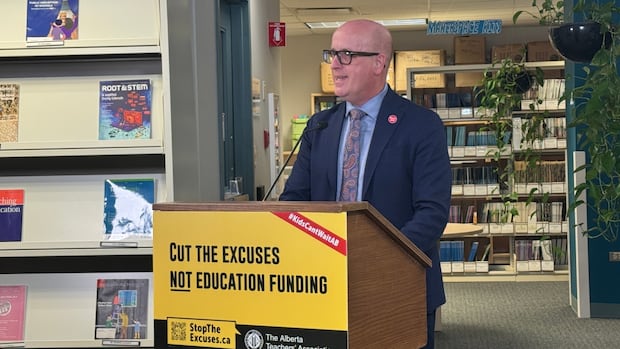The president of the Alberta Teachers’ Association says its bargaining team asked the provincial government if it can fund class size recommendations issued in 2003 following the province’s last major teachers’ strike.
ATA president Jason Schilling said on Alberta at Noon Wednesday that the province’s public, Catholic and francophone school divisions would need to hire more than 5,000 teachers to reach the recommended pupil-teacher ratios in that report.
“We’re still trying to see if government would move on those numbers,” Schilling said on the radio program. “But obviously, it’s something that is not of their interest.”
Schilling made the comments as 51,000 teachers are poised to go on strike on Monday.
Schilling and Finance Minister Nate Horner said in separate interviews on Alberta at Noon Wednesday that further talks between the teachers’ association and employers are unlikely before Monday.
Horner also said there are no plans to reconvene the legislature earlier than scheduled to impose back-to-work legislation on educators.
Commission recommended average class sizes
Following a 2002 strike of 22,000 teachers in 22 Alberta school divisions, the Progressive Conservative government of the day struck the Alberta Commission on Learning (ACOL) in response to educator concerns about growing class sizes.
In addition to recommending hundreds of millions of dollars in additional education spending to address pressures in schools, the commission reviewed research and recommended that kindergarten-to-grade 3 classes have an average of 17 children; Grade 4-6 classes have an average of 23 children; junior high classes have an average of 25 students; and high school classes have an average of 27 students.
Alberta at Noon52:39What does the looming teacher’s strike mean for you?
Barring an 11th hour deal, teachers will be on strike Monday. How do you feel about this? What will you do with your kids? Do you want teachers to pause the job action, and try to negotiate a deal?
“The impact of class size on educational outcomes is among the most researched topics in education,” said the 22-year-old report. “Reducing class size in the early grades (K-3) has been found to have academic benefits, especially for poor and minority children.”
The Alberta government stopped counting class sizes in 2019. Data from Edmonton Public Schools, which still measures it, and anecdotes from teachers, students and parents suggest many classes are now much larger than those recommendations.
Between 2020 and 2024, provincial data show Alberta’s student population has grown by 91,000, or about 12 per cent, bringing the number of students enrolled last school year to 825,817.
At least 730,000 students will have classes cancelled if teachers strike on Monday.
The ACOL report said the needs of individual students should be considered when deciding how many students are in each class, and that the government should fund Alberta schools so that the average class can achieve those targets.
After teachers rejected the province’s latest contract offer, the Alberta government held a news conference to express frustration over negotiations, and to announce new supports for parents. CBC’s Sarah Reid has more.
Class size and complexity, along with teacher pay increases lagging in comparison to inflation are sticking points in the contract dispute.
All parties agree the proportion of students with additional needs, such as disabilities, mental health challenges or who don’t fluently speak English have increased in the province’s schools during recent years.
Schilling has said employers have previously rebuffed any suggestion of class size caps or pupil-teacher ratios at the bargaining table.
“Teachers have gotten to the point where they’re like, ‘ We’ve had enough. It’s not sustainable. The system is broken. We’re in a crisis, and we have to fix it. And that’s why we’re taking this stand,'” he said.
A deal voted down earlier this week by nearly 90 per cent of ATA members included a commitment from the government to fund 3,000 net new teaching positions and 1,500 more educational assistant positions by August 2028.
No immediate back-to-work bill, minister says
Finance Minister Horner told Alberta at Noon host Ted Henley on Wednesday that teachers have the right to strike, and that the government could “potentially” force teachers back to work, but not right away.
“If you’re going to take that kind of action, that’s kind of a big hammer,” Horner said.
“You have to be in a position where it’s causing the kind of harm that can’t be undone — long-term educational harm to the students of Alberta.”

The Alberta legislature is scheduled to reconvene Oct. 23 with a Speech from the Throne, with the first day of routine business set for Oct. 27.
Horner said he hopes the contract dispute doesn’t reach this point.
Premier Danielle Smith said on Tuesday class size caps were off the table because the province doesn’t have enough school buildings to divide students into additional classes.
Horner said Wednesday the province is trying to catch up with that growth with an $8.6-billion, seven-year investment in the School Construction Accelerator Program, which aims to build 90 new schools and modernize around 40 more.
He said prioritizing new school space is “at the expense of every other piece of potential capital the province may need,” such as highway or bridge upgrades.
Education Minister Demetrios Nicolaides said in an interview on Edmonton AM Wednesday morning the government has just committed an additional $300 million over three years to fund more educational assistant jobs in schools.
Teachers also rejected a mediator’s recommendation in May.
The May offer, and the September offer, included a promised 12 per cent general wage increase over four years, with additional increases for many teachers in September 2026 as employers amalgamate them onto one salary grid.
Both Horner and Nicolaides said they are unclear what offer teachers would be willing to accept.
Schilling says the ATA and teachers have been clear they need wages that catch up and keep pace with the rising cost of living and measures to markedly improve students’ learning conditions.







